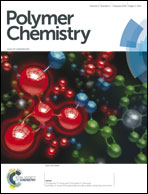Synthesis of high molar mass poly(n-butyl acrylate) and poly(2-ethylhexyl acrylate) by SET-LRP in mixtures of fluorinated alcohols with DMSO
Abstract
SET-LRP of n-butyl acrylate (nBA) and 2-ethylhexyl acrylate (EHA) initiated with bis(2-bromopropionyl)ethane (BPE) to synthesize high molar mass poly(nBA) and poly(EHA) was carried out in binary mixtures of 2,2,2-trifluoroethanol (TFE) or 2,2,3,3-tetrafluoropropanol (TFP) with DMSO at 50 °C. Using a solvent mixture of TFP containing 30% DMSO led for the first time to the synthesis of poly(nBA) with Mn = 527 700, Mw/Mn = 1.21 in 12 h, and poly(EHA) with Mn = 913 100, Mw/Mn = 1.20 in 15 h via SET-LRP. Although these two fluorinated alcohols provide complete solubilization of the hydrophobic monomers, nBA and EHA, and of the resulting polymers in addition to an efficient disproportionation of Cu(I)Br and subsequent stabilization of the Cu(II)Br2/L complex, SET-LRP targeting high molar mass poly(nBA) and poly(EHA) in these solvents alone resulted in a relatively slow polymerization with limited conversion. By contrast, DMSO, in spite of being the preferred solvent for SET-LRP with ability to disproportionate Cu(I)Br, stabilizes the “nascent” Cu(0) nanoparticle and provides an efficient SET process, generating a non-living polymerization for these hydrophobic monomers due to the insolubility of the resulting polymers. Remarkably, by a cooperative and synergistic effect, the binary mixtures of TFE or TFP with DMSO provide excellent reaction media for the synthesis of high molar mass poly(nBA) and poly(EHA) by SET-LRP.


 Please wait while we load your content...
Please wait while we load your content...